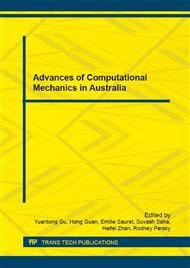[1]
Wolf J P, Song C M. Finite-Element Modelling of Unbounded Media [M] . New York: Wiley, (1996).
Google Scholar
[2]
Song C, Wolf J P. The scaled boundary finite-element method - alias consistent infinitesimal finite-element cell method - for elastodynamics [J]. Computer Methods in Applied Mechanics and Engineering, 1997, 147(3-4): 329-355.
DOI: 10.1016/s0045-7825(97)00021-2
Google Scholar
[3]
Wolf J P. The scaled boundary finite element method [M]. Chichester: John Wiley and Sons, (2003).
Google Scholar
[4]
Lin G, Du J G, Hu Z Q, et al. Earthquake Analysis Including the Effects of Foundation Inhomogeneity [J]. Frontiers of Architecture and Civil Engineering in China. 2007, 1(1): 41-50.
DOI: 10.1007/s11709-007-0004-4
Google Scholar
[5]
Bazyar M H, Song C. Transient analysis of wave propagation in non-homogeneous elastic unbounded domains by using the scaled boundary finite-element method [J]. Earthquake Engineering and Structural Dynamics, 2006, 35: 1787-1806.
DOI: 10.1002/eqe.606
Google Scholar
[6]
Bazyar M H, Song C. Time-harmonic response of non-homogeneous anisotropic unbounded domains using the scaled boundary finite-element method [J]. Earthquake Engineering and Structural Dynamics, 2006, 35: 357-383.
DOI: 10.1002/eqe.526
Google Scholar
[7]
Song C, Bazyar M H. A boundary condition in Padé series for frequency-domain solution of wave propagation in unbounded domains[J]. International Journal for Numerical Methods in Engineering, 2006, 69: 2330-2358.
DOI: 10.1002/nme.1852
Google Scholar
[8]
Bazyar M H, Song C. A continued-fraction based high-order transmitting boundary for wave propagation in unbounded domains of arbitrary geometry [J]. International Journal for Numerical Methods in Engineering, 2008, 74(2): 209-237.
DOI: 10.1002/nme.2147
Google Scholar
[9]
Shan Lu, Jun Liu, Gao Lin. High performance of the scaled boundary finite element method applied to the inclined soil field in time domain. Engineering Analysis with Boundary Elements, 2015, 56: 1-19.
DOI: 10.1016/j.enganabound.2015.01.014
Google Scholar
[10]
Xiaojun Chen, Carolin Birk , ChongminSong. Time-domain analysis of wave propagation in 3-Dunbounded domains by the scaled boundary finite element method [J]. Soil Dynamics and Earthquake Engineering , 2015, 75: 171-182.
DOI: 10.1016/j.soildyn.2015.04.009
Google Scholar
[11]
Wolf J P. Dynamic soil-structure interaction [M]. New Jersey: Prentice-Hall, (1985).
Google Scholar
[12]
Jin Feng, Zhang Chunhan, Wang Guanglun. A coupling FE-BE-IBE model for structure-foundation interactions. Journal of TSINGHUA University 1993; 33(2): 17-24. (in Chinese).
Google Scholar
[13]
Liu Jingbo, Lu Yandong. A direct method for analysis of dynamic soil-structure interaction. Chinese civil engineering 1998; 31(3): 55-64. (in Chinese).
Google Scholar
[14]
Liao Zhenpeng. Normal transmitting boundary conditions. Science in China (Series E) 1996, 26(2): 185-192. (in Chinese).
Google Scholar


